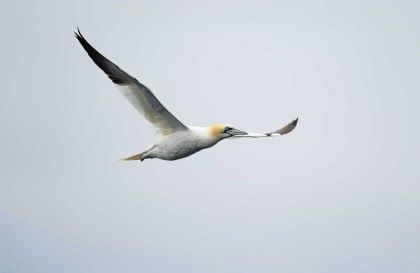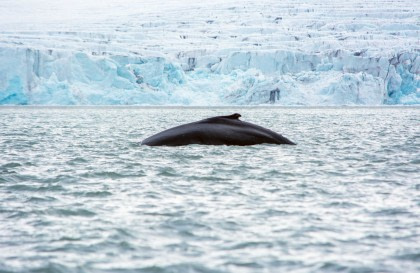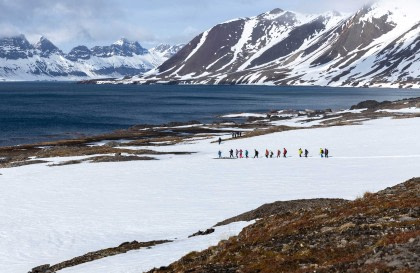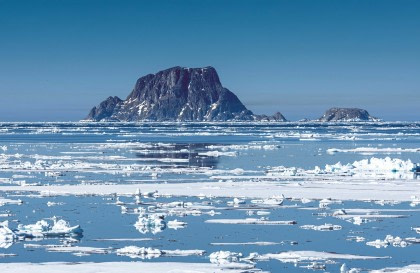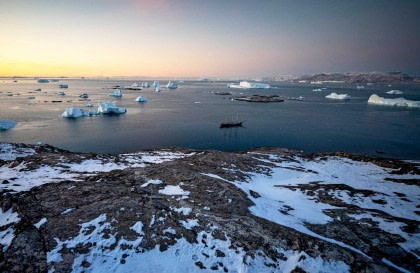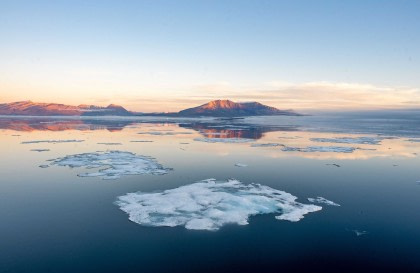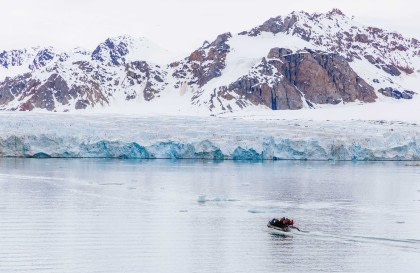The Arctic cruise overview
Special offers
Region
Destination
Ship
Language
Date
-
Show all
Outdoor activities
-
Show all
Experiences
-
Show all
Wildlife
-
Show all
Cruises
Alpine Peaks of Spitsbergen, Ski & Sail
24 Apr - 1 May, 2026
•Tripcode: RVR04-26
This program is designed for experienced ski mountaineers who have mastered techniques both for ascent and descent in challenging snow-covered alpine terrain. A typical day involves climbs to mountaintops averaging 700 - 850 meters (2,300 - 2780 feet)...
North Sea - Vlissingen to Aberdeen
25 May - 27 May, 2026
•Tripcode: OTL01-26
Search for whales, seals, and seabirds on a scenic voyage from our home port of Vlissingen to culturally rich Aberdeen, the "Granite City" of northeast Scotland. White-beaked dolphins, harbour porpoises, minke whales, orcas, and various species of seabird...
Arctic Ocean - Aberdeen, Fair Isle, Jan Mayen, Ice edge, Spitsbergen, Birding
25 May - 5 Jun, 2026
•Tripcode: OTL01C26
Search for whales, and other Arctic wildlife of the land, sea, and air on an adventurous voyage from our home port of Vlissingen to our favorite Arctic island group.
19 Days Extensive Arctic Ocean - North Spitsbergen Explorer
25 May - 12 Jun, 2026
•Tripcode: OTL01D26
Sailing between our home port of Vlissingen and our most cherished Arctic archipelago, Svalbard, this expedition adventure visits the Scottish port of Aberdeen, the islands of Fair Isle and Jan Mayen, and the amazing Spitsbergen ice edge, giving you...
Arctic Ocean - Fair Isle, Jan Mayen, Ice Edge, Spitsbergen, Birding
27 May - 5 Jun, 2026
•Tripcode: OTL02-26
Search for whales, and other Arctic wildlife of the land, sea, and air on an adventurous voyage from the Scottish port of Aberdeen to our favorite Arctic island group.
17 Days Extensive Arctic Ocean - North Spitsbergen Explorer
27 May - 12 Jun, 2026
•Tripcode: OTL02C26
Sailing between the Scottish port of Aberdeen and our most cherished Arctic archipelago, Svalbard, this expedition adventure visits the islands of Fair Isle and Jan Mayen, and the amazing Spitsbergen ice edge, giving you the chance to search for whales,...
North Spitsbergen - Arctic Spring , Hike & Sail
29 May - 5 Jun, 2026
•Tripcode: RVR08-26
At the end of a long Arctic winter, spring is starting to awaken. The climate, however, is still shrouded in cold. Expect ice-covered mountains, snow-swept shores, and temperatures around –4 °C (25°F). It’s a good time to experience the last of the winter...
Northwest Iceland Explorer - Into the Greenland sea ice
29 May - 5 Jun, 2026
•Tripcode: HDS02-26
Enter a world of Norse mythology, wild, dramatic coastlines, and seabirds in their thousands as you voyage from Iceland, crossing the Arctic Circle and encountering the fringes of the sea ice, with good possibilities of viewing seals, whales, and a lonely...
Arctic Ocean – Northwest Iceland - Pack Ice – Grimsey – Jan Mayen – Ice Edge – Spitsbergen
29 May - 13 Jun, 2026
•Tripcode: HDS02C26
This unique Arctic adventure takes you from Iceland's magical fjords and the isle of Grimsey into the pack ice of Greenland's rugged coastline, before exploring wild and remote Jan Mayen and delving into the Greenland Sea's pack ice. Finish your adventure...
22 Days Extensive Arctic Ocean – Northwest Iceland - Spitsbergen Explorer
29 May - 20 Jun, 2026
•Tripcode: HDS02D26
Leaving Iceland's magical fjords and the isle of Grimsey behind, voyage into the pack ice of the Denmark Strait and stop by remote Jan Mayen before navigating pack ice on your way to Spitsbergen. Watching for iconic wildlife along the way, you'll venture...
Arctic Ocean - Jan Mayen, Ice edge, Spitsbergen, Birding
5 Jun - 13 Jun, 2026
•Tripcode: HDS03-26
Voyage from the volcanic shores of Iceland to the icy fjords and snow-capped peaks of Spitsbergen, crossing the Arctic Circle, visiting remote Jan Mayen with its rich seabird life, and following the edge of the ice as you go. Watch for whales, seals,...
North Sea - Vlissingen to Aberdeen
10 Jun - 12 Jun, 2026
•Tripcode: PLA03-26
Search for whales, seals, and seabirds on a scenic voyage from our home port of Vlissingen to culturally rich Aberdeen, the "Granite City" of northeast Scotland. White-beaked dolphins, harbour porpoises, minke whales, orcas, and various species of seabird...
Arctic Ocean - Aberdeen, Fair Isle, Jan Mayen, Ice edge, Spitsbergen, Birding
10 Jun - 21 Jun, 2026
•Tripcode: PLA03C26
Search for whales, and other Arctic wildlife of the land, sea, and air on an adventurous voyage from our home port of Vlissingen to our favorite Arctic island group.
19 Days Extensive Arctic Ocean - North Spitsbergen Explorer
10 Jun - 28 Jun, 2026
•Tripcode: PLA03D26
Sailing between our home port of Vlissingen and our most cherished Arctic archipelago, Svalbard, this expedition adventure visits the Scottish port of Aberdeen, the islands of Fair Isle and Jan Mayen, and the amazing Spitsbergen ice edge, giving you...
Arctic Ocean - Fair Isle, Jan Mayen, Ice edge, Spitsbergen, Birding - Summer Solstice
12 Jun - 21 Jun, 2026
•Tripcode: PLA04-26
Search for whales, and other Arctic wildlife of the land, sea, and air on an adventurous voyage from the Scottish port of Aberdeen to our favorite Arctic island group.
North Spitsbergen Explorer - Into the pack ice - Polar Bear Special
12 Jun - 19 Jun, 2026
•Tripcode: OTL04-26
This expedition focuses on the pack ice of north Spitsbergen and many opportunities to spot whales, polar bears, seabirds, walruses, and other such wildlife.
17 Days Extensive Arctic Ocean - North Spitsbergen Explorer
12 Jun - 28 Jun, 2026
•Tripcode: PLA04C26
Sailing between the Scottish port of Aberdeen and our most cherished Arctic archipelago, Svalbard, this expedition adventure visits the islands of Fair Isle and Jan Mayen, and the amazing Spitsbergen ice edge, giving you the chance to search for whales,...
North Spitsbergen Explorer - Versatile landscapes, sea ice & wildlife
13 Jun - 20 Jun, 2026
•Tripcode: HDS04-26
This expedition focuses on the versatility of North Spitsbergen’s visually stunning landscapes, vast spans of sea ice, and many opportunities to spot whales, polar bears, seabirds, walruses, and other such wildlife. Enjoy the fantastically beautiful...
North Spitsbergen Basecamp – Summer Solstice - Free Kayaking, Hiking, Photo Workshop, Diving (supplemented)
19 Jun - 26 Jun, 2026
•Tripcode: OTL05-26
The North Spitsbergen Basecamp cruise offers you a myriad of ways to explore and enjoy this Arctic Region. This expedition allows you to hike, snowshoe, kayak, and learn to take perfect pictures of the polar flora and fauna.
North Spitsbergen Explorer - Versatile landscapes, sea ice & wildlife - Summer Solstice
20 Jun - 27 Jun, 2026
•Tripcode: HDS05-26
This expedition focuses on the versatility of north Spitsbergen’s visually stunning landscapes, vast spans of sea ice, and many opportunities to spot whales, polar bears, seabirds, walruses, and other such wildlife. Enjoy the fantastically beautiful...
North Spitsbergen - Arctic Summer
25 Jun - 5 Jul, 2026
•Tripcode: RVR11-26
The North Spitsbergen cruise sails to some of the remotest locations of Northern Europe. The expedition gives you the opportunity to spot historic whaling remains, glaciers, a variety of Arctic birds including the little auk , and polar bears.
East Spitsbergen - Home of the Polar Bear, Including Long Hikes & Cleaning the Shores
26 Jun - 3 Jul, 2026
•Tripcode: OTL06-26
Experience the high Arctic summer solstice with an expedition that visits some of the top sites of eastern Spitsbergen. Our goal is to take you to amazing glaciers, fascinating historical sites, bountiful seabird colonies, and sprawling fjord systems...
Around Spitsbergen, In the realm of Polar Bear & Ice
27 Jun - 6 Jul, 2026
•Tripcode: HDS06-26
Take a cruise around Spitsbergen and explore the icy waters of the North Atlantic. This special expedition offers you the chance to catch sight of whales, reindeer, Arctic foxes, walruses, seals, and the star attraction, the polar bear.
North Spitsbergen Explorer – Into the Pack Ice – Polar Bear & Whale Special
28 Jun - 7 Jul, 2026
•Tripcode: PLA06-26
This expedition focuses on the pack ice of north Spitsbergen and many opportunities to spot whales, polar bears, seabirds, walruses, and other such wildlife.
Around Spitsbergen, In the realm of Polar Bear & Ice
3 Jul - 12 Jul, 2026
•Tripcode: OTL07-26
Take a cruise around Spitsbergen and explore the icy waters of the North Atlantic. This special expedition offers you the chance to catch sight of whales, reindeer, Arctic foxes, walruses, seals, and the star attraction, the polar bear.
North Spitsbergen - Arctic Summer
5 Jul - 15 Jul, 2026
•Tripcode: RVR12-26
The North Spitsbergen cruise sails to some of the remotest locations of northern Europe. The expedition gives you the opportunity to spot historic whaling remains, glaciers, a variety of Arctic birds including the Little Auk, and polar bears.
Around Spitsbergen, In the realm of Polar Bear & Ice
6 Jul - 15 Jul, 2026
•Tripcode: HDS07-26
Take a cruise around Spitsbergen and explore the icy waters of the North Atlantic. This special expedition offers you the chance to catch sight of whales, reindeer, Arctic foxes, walruses, seals, and the star attraction, the polar bear.
Around Spitsbergen, In the realm of Polar Bear & Ice
7 Jul - 16 Jul, 2026
•Tripcode: PLA07-26
Take a cruise around Spitsbergen and explore the icy waters of the North Atlantic. This special expedition offers you the chance to catch sight of whales, reindeer, Arctic foxes, walruses, seals, and the star attraction, the polar bear.
Around Spitsbergen, In the realm of Polar Bear & Ice
12 Jul - 21 Jul, 2026
•Tripcode: OTL08-26
Take a cruise around Spitsbergen and explore the icy waters of the North Atlantic. This special expedition offers you the chance to catch sight of whales, reindeer, Arctic foxes, walruses, seals, and the star attraction, the polar bear.
Around Spitsbergen, In the realm of Polar Bear & Ice
15 Jul - 24 Jul, 2026
•Tripcode: HDS08-26
Take a cruise around Spitsbergen and explore the icy waters of the North Atlantic. This special expedition offers you the chance to catch sight of whales, reindeer, Arctic foxes, walruses, seals, and the star attraction, the polar bear.
Around Spitsbergen, In the realm of Polar Bear & Ice
16 Jul - 25 Jul, 2026
•Tripcode: PLA08-26
Take a cruise around Spitsbergen and explore the icy waters of the North Atlantic. This special expedition offers you the chance to catch sight of whales, reindeer, Arctic foxes, walruses, seals, and the star attraction, the polar bear.
Around Spitsbergen, In the realm of Polar Bear & Ice
21 Jul - 30 Jul, 2026
•Tripcode: OTL09-26
Take a cruise around Spitsbergen and explore the icy waters of the North Atlantic. This special expedition offers you the chance to catch sight of whales, reindeer, Arctic foxes, walruses, seals, and the star attraction, the polar bear.
Spitsbergen - Northeast Greenland, Fly & Sail
12 Aug - 31 Aug, 2026
•Tripcode: RVR15-26
The Spitsbergen and Northeast Greenland cruise sails waters filled with breath-taking scenery. The expedition passes through areas that are home to seals, seabirds, whales, and polar bears.
Northeast Greenland Extreme
15 Aug - 28 Aug, 2026
•Tripcode: HDS11-26
Venturing to the dramatic, rugged coastline of Northeast Greenland, you'll enter the world's largest fjord, Scoresby Sund, encountering whales, seabirds, and musk oxen before voyaging north through the most beautiful straits and fjords. Along the way,...
East Greenland, Scoresby Sund, Including Long Hikes
16 Aug - 25 Aug, 2026
•Tripcode: PLA11-26
The East Greenland – Scoresby Sund cruise crosses the Arctic Circle into the home waters of multiple species of whale. The expedition will spot huge icebergs as it journeys into the largest and deepest fjord system in the world.
Around Spitsbergen incl. Nordaustlandet
17 Aug - 26 Aug, 2026
•Tripcode: OTL12-26
This cruise around Spitsbergen gives you a great chance to see whales, foxes, reindeer, seals, and polar bears.
Northeast Greenland Extreme
25 Aug - 7 Sep, 2026
•Tripcode: PLA12-26
Venturing to the dramatic, rugged coastline of Northeast Greenland, you'll enter the world's largest fjord, Scoresby Sund, encountering whales, seabirds, and musk oxen before voyaging north through the most beautiful straits and fjords. Along the way,...
Four Islands | Iceland- Northeast Greenland-Spitsbergen- Bear Island
25 Aug - 12 Sep, 2026
•Tripcode: PLA12C26
Chart an epic course from Iceland into the mazy fjords of Greenland and the beautiful world of the pack ice as you head north. Crossing the Greenland Sea, this combination cruise then takes you through the Svalbard Archipelago, exploring glaciers, mountains,...
Around Spitsbergen incl. Nordaustlandet
26 Aug - 4 Sep, 2026
•Tripcode: OTL13-26
This cruise around Spitsbergen gives you a great chance to see whales, foxes, reindeer, seals, and polar bears.
South Spitsbergen - Bear Island - Norway
7 Sep - 12 Sep, 2026
•Tripcode: PLA13A26
Chart the icy waters of Spitsbergen, exploring spectacular fjords and glaciers in Hornsund, a world of imposing sea cliffs and Arctic history. With seas rich in seals and whales, there are chances for spotting polar bears throughout. Before reaching...














